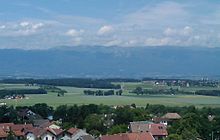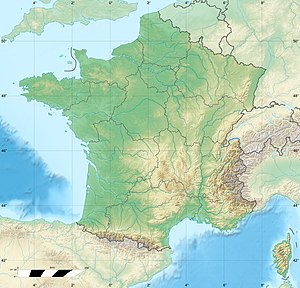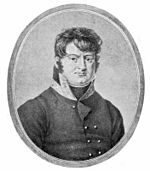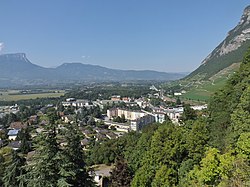
The Battle of Brienne saw an Imperial French army led by Emperor Napoleon attack Prussian and Russian forces commanded by Prussian Field Marshal Gebhard Leberecht von Blücher. After heavy fighting that went on into the night, the French seized a château, nearly capturing Blücher. However, the French were unable to dislodge the Russians from the town of Brienne-le-Château. Napoleon himself, making his first appearance on a battlefield in 1814, was also nearly captured. Very early the next morning, Blücher's troops quietly abandoned the town and retreated to the south, conceding the field to the French.

The Battle of Montereau was fought during the War of the Sixth Coalition between an Imperial French army led by Emperor Napoleon and a corps of Austrians and Württembergers commanded by Crown Prince Frederick William of Württemberg. While Napoleon's army mauled an Allied army under Gebhard Leberecht von Blücher, the main Allied army commanded by Karl Philipp, Prince of Schwarzenberg, advanced to a position dangerously close to Paris. Gathering up his outnumbered forces, Napoleon rushed his soldiers south to deal with Schwarzenberg. Hearing of the approach of the French emperor, the Allied commander ordered a withdrawal, but on 17 February saw his rear guards overrun or brushed aside.
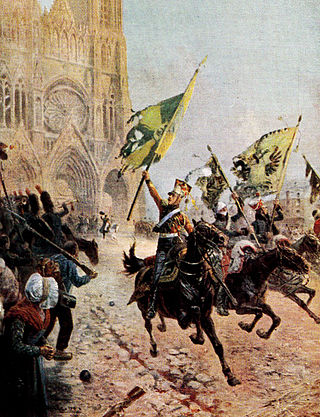
The Battle of Reims was fought at Reims, France between an Imperial French army commanded by Emperor Napoleon and a combined Russian-Prussian corps led by General Emmanuel de Saint-Priest. On the first day, Saint-Priest's Russians and General Friedrich Wilhelm von Jagow's Prussians easily captured Reims from its French National Guard garrison, capturing or killing more than half of its defenders. On the second day, an overconfident Saint-Priest carelessly deployed his forces west of the city, not grasping that Napoleon was approaching with 20,000 troops. Too late, Saint-Priest realized who he was fighting and tried to organize a retreat. In the battle that followed, the French army struck with crushing force and the Allies were routed with serious losses. During the fighting, Saint-Priest was struck by a howitzer shell and died two weeks later.

Ferdinand, Graf Bubna von Littitz was a Field marshal lieutenant (Feldmarschalleutnant) of the Imperial Austrian Army during the Napoleonic Wars and also an Austrian Privy Councillor. Bubna is remembered for his role in the liberation of Geneva and the Léman region from fifteen years of French occupation on 29 December 1813. His actions were partially responsible for the creation of the Canton of Geneva which was finalized in 1814-15 at the Congress of Vienna.
Louis François Félix Musnier de La Converserie became a general officer during the French Revolutionary Wars and led a division during the Napoleonic Wars. He joined the French Royal Army as an officer in 1781 after a spell in military school. Still a lieutenant in 1788, he enjoyed rapid promotion during the French Revolution. After serving as a general's aide, he was assigned to fight rebels in the Vendée. Later, he served as Adjutant General on two army staffs. In 1798 he was promoted to general of brigade for distinguished actions in Italy.
The VII Corps of the Grande Armée was a French military unit that existed during the Napoleonic Wars. It was formed in 1805 and assigned to Marshal Pierre Augereau. From 1805 to 1807, Augereau led the VII Corps in the War of the Third Coalition and the War of the Fourth Coalition. It was disbanded after being nearly wiped out at the Battle of Eylau in February 1807 and its surviving troops were distributed to other corps.
Paul von Radivojevich was an Austrian army corps commander in the army of the Austrian Empire during the late Napoleonic Wars. He joined the army of the Habsburg monarchy in 1782 and fought in one of the early battles of the French Revolutionary Wars. He led a Grenz Infantry Regiment before being promoted to general officer in 1807. He led a brigade at Eckmühl in 1809, a division in the summer of 1813, and a corps at Caldiero in 1813 and at the Mincio in 1814. During the 1815 Italian campaign, he led a corps in Switzerland, Piedmont, and France. After the wars, he commanded part of the Military Frontier. He was Proprietor (Inhaber) of an infantry regiment from 1815 until his death in 1829.
The VI Cavalry Corps of the Grande Armée was a French military unit that had an ephemeral existence during the Napoleonic Wars. The corps was created on 9 February 1814 and General François Étienne de Kellermann was appointed as its commander. The corps was formed by combining a newly arrived dragoon division from the Spanish front, a second dragoon division, and a light cavalry division made up of hussars and Chasseurs-à-Cheval. The latter two divisions included units from the former III Cavalry Corps. Kellermann led the VI Cavalry Corps at Mormant, Troyes, Bar-sur-Aube, Laubressel, and Saint-Dizier. After Emperor Napoleon Bonaparte abdicated in early April, the corps ceased to exist.

The Battle of Gué-à-Tresmes was fought between 14,500 French troops led by Marshals Auguste de Marmont and Édouard Mortier and 12,000 Prussians commanded by Friedrich Graf Kleist von Nollendorf and Friedrich von Katzler. On 28 February the French attacked and drove the Prussians to the north along the west bank of the river Ourcq. That evening and the next day Kleist tried to push the French back while Russian units under Peter Mikhailovich Kaptzevich tried to cross from the east to the west bank of the Ourcq; the Allies were unsuccessful. Gué-à-Tresmes is located where Route D405 crosses the Thérouanne stream about 10 kilometres (6.2 mi) northeast of Meaux.

The Battle of Limonest saw 30,000-53,000 Austrian and Hessian troops led by Prince Frederick of Hessen-Homburg defeat 20,000-23,000 French troops under Marshal Pierre Augereau.

The First Battle of Bar-sur-Aube was fought during the War of the Sixth Coalition when Marshal Édouard Mortier, duc de Trévise's corps of French Imperial Guards defended against an Austrians corps under Ignaz Gyulai and a Württemberger corps led by Crown Prince Frederick William of Württemberg. After holding his main defensive positions in stiff fighting, Mortier withdrew his elite troops during the night and retreated to Troyes. Bar-sur-Aube is located 53 kilometres (33 mi) east of Troyes.

The Battle of Mâcon saw a French division under Louis François Félix Musnier attack an Austrian corps led by Frederick Bianchi, Duke of Casalanza. The French enjoyed initial success but their numerical inferiority led to their defeat in this War of the Sixth Coalition clash. Mâcon is located 72 kilometres (45 mi) north of Lyon.
The Battle of Courtrai saw Johann von Thielmann's Kingdom of Saxony troops and a few Prussians encounter an Imperial French force under Nicolas Joseph Maison near Kortrijk (Courtrai), a city south-west of Ghent in what is now Belgium. Thielmann attacked only to find himself facing the bulk of Maison's I Corps. The action ended in a rout of the Saxons, most of whom were under fire for the first time.

The Battle of Arnhem saw Friedrich Wilhelm Freiherr von Bülow's Prussian corps fight an Imperial French division under Henri François Marie Charpentier at Arnhem. Attacking under the cover of fog, the Prussians broke into the city at several points and forced the French to retreat to Nijmegen after hard fighting in this War of the Sixth Coalition clash. Arnhem is a city in the Netherlands located on the Rhine River 100 kilometres (62 mi) southeast of Amsterdam.
François Pierre Joseph Amey became a French division commander during the Napoleonic Wars. He enlisted in the French Royal Army in 1783 and joined a volunteer battalion in 1792. He won promotion to general of brigade in 1793 during the War in the Vendée. He held a command during the period of the infernal columns and his career became obscure until 1799 when he supported Napoleon's coup. He went on the Saint-Domingue expedition in 1802–1803 and later filled posts in the interior. In 1806–1807 he led a brigade at Jena, Golymin and Eylau where he was wounded.

The Battle of Laubressel saw the main Allied army of Field Marshal Karl Philipp, Prince of Schwarzenberg mount a three-pronged converging attack on the weaker army of Marshal Jacques MacDonald. The French forces under Marshal Nicolas Oudinot bore the brunt of the fighting, in which the Allies tried to turn their left flank. The French abandoned Troyes and retreated west as a result of the action. The village of Laubressel is located 10 kilometres (6 mi) east of Troyes.

Claude Marie Meunier became a French division commander during the Napoleonic Wars. He joined a volunteer regiment in 1792 and fought on the Rhine and in Italy as a captain. After a stint in the Consular Guard as a major, he became colonel of the 9th Light Infantry Regiment in 1803. His regiment fought at Haslach and Dürenstein in 1805, Halle, Waren and Lübeck in 1806, and Mohrungen and Friedland in 1807. Transferred to Spain, he led his troops at Uclés, Medellín and Talavera in 1809. He was promoted general of brigade in 1810 and fought at Barrosa in 1811.

General of Division Baron Pierre Decouz became a French division commander during the later Napoleonic Wars. He was born in the Kingdom of Sardinia but after the region was annexed to France, he joined a volunteer battalion in 1793. He fought in Italy during the War of the First Coalition. He participated in the French campaign in Egypt and Syria, fighting at the Pyramids, Acre and Abukir. After distinguishing himself at Austerlitz in 1805, he was promoted to command an infantry regiment. In 1806–1807 he led his regiment at Auerstädt, Pultusk and Eylau. In 1809 he fought at Eckmühl, Ratisbon and Wagram, winning promotion to general of brigade. After leading an Imperial Guard brigade at Lützen and Bautzen in 1813, he was promoted general of division. He commanded a Young Guard division at Dresden and Leipzig. Still leading a Young Guard division, he was fatally wounded at the Battle of Brienne and died three weeks later. His surname is one of the names inscribed under the Arc de Triomphe, on Column 17.

Pierre Barrois became a French division commander during the Napoleonic Wars. He joined a volunteer battalion in 1793 that later became part of a famous light infantry regiment. He fought at Wattignies, Fleurus, Aldenhoven, Ehrenbreitstein and Neuwied in 1793–1797. He fought at Marengo in 1800. He became colonel of a line infantry regiment in 1803 and led it at Haslach, Dürrenstein, Halle, Lübeck and Mohrungen in 1805–1807. Promoted to general of brigade, he led a brigade at Friedland in 1807.

Wenzel Joseph von Colloredo-Mels und Wallsee served in the army of Habsburg Austria from the middle to the end of the 18th century. For the subsequent two decades, he continued to serve the Austrian military in non-combat roles. During the Seven Years' War, he fought at Prague, Maxen, Torgau, and other actions. He held field commands in the Austro-Turkish War. During the War of the First Coalition he led troops at Neerwinden, Raismes, Famars, Caesar's Camp, and Maubeuge. In 1784, he became Proprietor (Inhaber) of an Austrian infantry regiment and held the position until his death. He was promoted Field Marshal in 1808.
